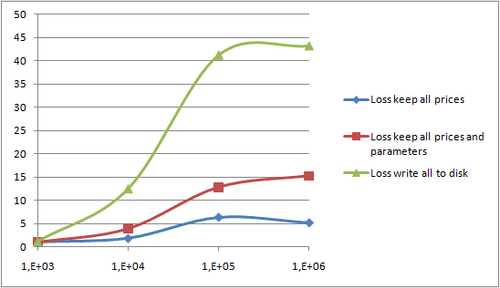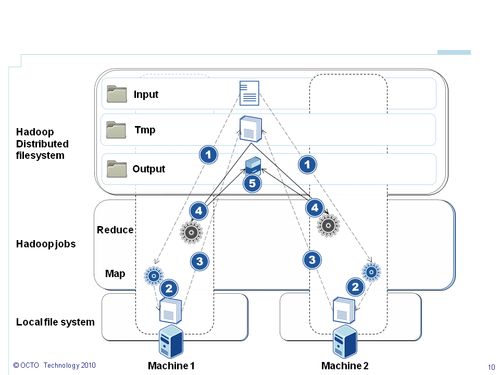Using Hadoop for Value At Risk calculation Part 1
After introducing the Value at Risk in my first article, I have implemented it using GridGain in my second article. I conclude in this latter that relatively good performances have been reached through some optimizations. One of them was based on the hypothesis that the intermediate results - the prices for each draw - can be discarded. However, it is not always the case. Keeping the generated parameters and the call price for each draw can be very useful for business in order to analyze the influence of the different parameters. Such data are often crunched by Business Intelligence. VAR calculation is maybe not the best business use case in order to illustrate that need but I will reuse it as it has already been defined. The purpose of this new series of articles will be to compute the Value at Risk and keep all results, to be able to analyze them.
- In this first part, I will describe how to persist that data both with GridGain and with Hadoop;
- In the three next parts I will go into details of different implementations with Hadoop. These parts provide interesting code examples but can be safely discard in first read;
- Then in the fifth part, I will show how to use Hadoop to do Business Intelligence on the data;
- And in the last part, I will give some performance figures and improvement possibilities.
In these articles, some portions of the code were removed when nothing was changed since the last article and replaced by comment (//Unchanged...).
Evolution of the current implementation
The easiest way to do it is by modifying the current implementation. I created for that purpose a Result class holding parameters and price for each draw. It implements Serializable to be easily stored on the disk and comparable in order for it to be sorted like the price.
public class Result implements Serializable, Comparable<result> {
private final Parameters parameters;
private final double price;
//Constructor, getters, compareTo(), equals(), hashCode(), toString() implementations...
}
computeVar() signature is modified accordingly.
public SortedSet<result> computeVar(...) throws MathException {
//Unchanged...
for (int i = 0; i < drawsNb; i++) {
//Unchanged....
final Result result = new Result(new Parameters(optionPricer.getParameters()),price);
// For each draw, put the price in the sorted set
smallerPrices.add(result);
if(configuration.isCombineAllowed()) {
//Unchanged...
}
}
return smallerPrices;
}
Finally the results are written to disk by calling FilePersistenceManager.writeToDisk() which basically delegates to an ObjectOutputStream plugged to the disk.
Some measures, on the same laptop, show performance drawbacks as expected:
- Heap memory consumption increased since a collection of
Resultobjects is bigger than a collection of simpledouble. In fact, on my 32 bits machine, I wasn't able to generate more than 1,000,000 results. - More computing over-head to manage the
Resultobjects - Writing data to disk leads to a high I/O rate. Writing a file of 1,000,000 results with Java serialization leads to a 61 MB file. My hard drive was saturated with a sustained load of 7 MB/s.
The following graph shows the loss of storing the intermediate results defined like hereunder, thru different scenarios
- "combine" optimization (reference implementation): only 10% of the total number or draws are sent back to the client function. See the first article;
- Without optimization: all prices resulting for the draws are sent back to the client;
- Full result: both prices and parameters used to compute these prices are sent back to the client;
- Write to disk: the results are stored to disk using Java serialization.

Hadoop choice
Hadoop presentation
Hadoop, an Apache project self-defines itself as an open-source software for reliable, scalable, distributed computing. According to Wikipedia it enables applications to work with thousands of nodes and petabytes of data. In brief, it is a tool employed by Yahoo to process huge volume of data. It's architecture was inspired by Google MapReduce and Distributed File System. I will not describe it any further. Please refer to and refers to this article for additional information.
Why choosing Hadoop?
I decided to implement this VAR calculation on Hadoop for 3 reasons:
- Such architecture has proven itself for some of the largest computing tasks of today such as indexing the web.
- Hadoop is based on the map/reduce pattern which is the basis of my VAR implementation
- Emergence of the new paradigm, named "NoSQL", paves the way for new architecture and that article was an occasion to investigate it today.
More specifically, "NoSQL" architectures are well suited for BI analysis. So I wanted to see if it would be possible to combine the two functions in one tool. One of the advantage would be to limit the quantity of data moved back and forth. For that purpose I used both Hadoop for map/reduce and Hive for data analysis. Hive is a kind of simplistic warehousing system built on top of Hadoop. In practice, it provides a DSL very close to SQL, which is translated by Hive into map/reduce actions. I will refer you to that article for Hive installation details.
Hadoop & Hive implementation
Hadoop and Hive are systems based on file manipulation (keep in mind they are based on a distributed file system). Hadoop consists in a Distributed File System, which enables to share code and data between nodes, and a bunch of jobs, divided into map and reduce tasks, coordinated by Hadoop framework. So Hadoop provides out of the box:
- Distributed storage and split of data: each file is stored as a bunch of blocks distributed through the physical machine with potential replication. Programmer vision is a filesystem, Hadoop manages distribution.
- Coordination of job with local affinity. In order to drastically improve performance for high volume of data, tasks are executed on the node where the concerned data lies in
Hadoop processes files. I have written the following input file.
1;252;120.0;120.0;0.05;0.2;0.15;1000;0.99;250
1;252;120.0;120.0;0.05;0.2;0.15;1000;0.99;250
1;252;120.0;120.0;0.05;0.2;0.15;1000;0.99;250
1;252;120.0;120.0;0.05;0.2;0.15;1000;0.99;250
Each line means: Compute 250 draws of the call price with the following parameters (t=252 days, s0=120€, k=120€, r=0.05%, sigma=0.2, historicalVolatility=0.15) for scenario 1. The goal is to compute 1% VAR (0.99) on 1000 draws. Please refer to my previous article for an explanation about that parameters. The process of a Hadoop job is as follow. The number corresponds to the labels on the schema and are sorted in chronological order: 
- 1. I choose to split data line by line (use of
NLineInputFormat, described in a next part of that serie) meaning that each line will be send to amapslot); - 2. 250 draws are processed in the
mapphase and prices are computed. Results are temporarily stored on the local file system. The output format will be key-value as described hereafter; - 3. Results are pre-sorted by key and shared through the file system;
- 4. Results are sent to the
reducetask. For the purpose of that first implementation I didn't use thereduceside as we will see in the next part; - 5. Results are shared in the distributed file system.
So, the implementation with GridGain has shown that storing all results of disk have performance impact. Hadoop is a different tool. It is less optimized for computing intensive task but provides an efficient framework for distributing processing of large data. It's implementation of the map/reduce pattern is quite different from GridGain and needs some adaptation of the way to compute the VAR. We will discuss in the next part the detailed implementation of the VAR calculation with Hadoop. The next three parts will be focused on coding and implementation details. If you are only a bit interested in technical details, you can skip these parts in first read and wait for the 4th part in which I will describe how to analyse the intermediate values.